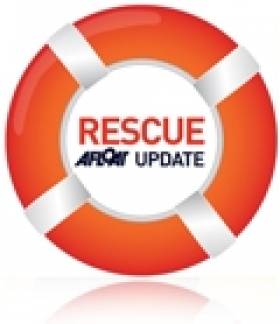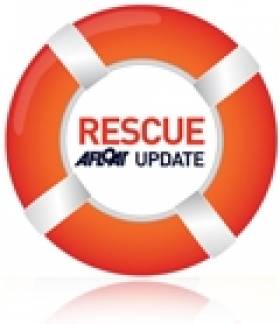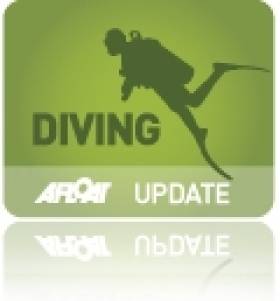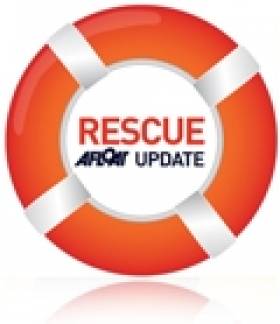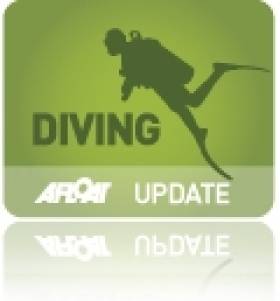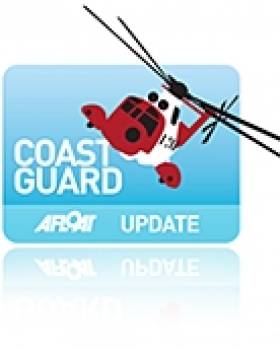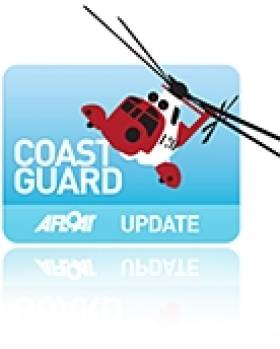Displaying items by tag: Rescue
Hypothermic Casualty Rescued From Water At Dollymount
#Rescue - BreakingNews.ie reports on the rescue of a man from the water at Dollymount Strand on Monday morning (27 October).
Emergency services were dispatched to the scene after a passer-by expressed concern for a person seen in the cold water at the Bull Island beach.
Some 30 minutes later the casualty was sighted by Irish Coast Guard helicopter Rescue 116 and winched on board.
The man was found to be unconscious and diagnosed with severe hypothermia, and was taken to Beaumont Hospital for treatment.
Two days previous a similar alert at the same beach for a kitesurfer in difficulty was stood down, as the Irish Examiner reports, when the man in question was discovered to have made the lengthy swim back to shore.
Man Overboard From Rosslare Ferry, Bray Head Climber In Fall
#Rescue - RTÉ News reports on two separate coastal rescues off Rosslare and Bray Head yesterday (Sunday 12 October).
One man fell overboard from Irish Ferries' Oscar Wilde ferry sailing out of Rosslare Europort about an hour after leaving port.
The passenger was recovered from the water and returned to Rosslare, from where he was taken to Wexford General Hospital.
Meanwhile, earlier in the day another man was hospitalised with head and back injuries after a fall while climbing Bray Head with friends.
RTÉ News has more on the story HERE.
Man Rescued Sailing To America In Flimsy Dinghy
#Rescue - Lifeboat volunteers on the Dorset coast went to the rescue of a man attempting to sail to America in a 14ft dinghy, as NewsTalk.ie reports.
Mudeford RNLI were launched after reports from a passing yacht that had concerns about the solo offshore boater.
On arrival, the lifeboat crew found the Bulgarian national on the dinghy was "exceedingly cold, wet and violently ill" yet was refusing their assistance.
They soon ascertained that the 30-year-old man, who has a US visa, had bought the dinghy earlier that day, packed it with some meagre supplies – without any suitable safety equipment or navigation aids – and set out to cross the Atlantic.
"He would have died [if we left him there," said lifeboat crewman Pete Dadds. "He was severely sea sick, he had the first signs of hypothermia and his boat was filling up with water."
NewsTalk.ie has more on the story HERE.
Dog Tweets Thanks To Rescuers After Perilous Atlantic Cliff Fall
#TwitterDog - A little dog who survived a 90-metre fall into the Atlantic Ocean on Sunday 3 August has thanked his rescuers - via his own Twitter account.
TheJournal.ie has much more on the story of Vimes the dog, who was plucked from the water below Lookout Point in Co Clare by the Kilkee unit of the Irish Coast Guard on Sunday afternoon
Vimes was very fortunate to avoid sustaining any injuries as he fell down the cliff face, as The Irish Times reports, and is now safe at home making a full recovery.
Divers Rescued Off Clare Coast As Boat Drifts Towards Rocks
#Diving - A group of scuba diving enthusiasts had a lucky escape yesterday (Saturday 2 August) after their boat drifted towards rocks off the Clare coast, as Independent.ie reports.
The six divers and the boat's skipper had been on an expedition in Liscannor Bay less than half a kilometre from the shore when the boat suffered engine failure.
The group was left adrift as weather conditions deteriorated, but the Irish Coast Guard's Doolin unit responded swiftly, along with the Shannon-based coastguard helicopter Rescue 115.
Independent.ie has more on the story HERE.
West Cork Kayakers Rescue Lough Hyne Swimmer
#Rescue - The Southern Star reports on the rescue of a swimmer in Lough Hyne by two passing kayakers last Sunday (27 July).
West Cork Kayaking Club members Declan McCarthy and David Sprott were within earshot of the man's call for help as he got into difficulty off Castle Island and rushed to his aid.
Another swimmer nearby joined the kayakers in guiding the man to the safety of the shore.
The Southern Star has more on the story HERE.
No Funding For Sub-Aqua Rescue Says Varadkar
#Diving - Minister Leo Varadkar has confirmed that diving teams who regularly assist in emergency operations will not qualify for grants available to volunteer rescue groups.
As TheJournal.ie reports, volunteer teams such as those under the Mountain Rescue Ireland and Community Rescue Boats Ireland umbrellas are in receipt of payments or grants of up to €5,000.
But no such payments are available to volunteer diving groups that provide assistance for Naval Service and Garda dive teams, which are co-ordinated by the Irish Coast Guard.
In response to a Dáil question from independent deputy Denis Naughten, the Minister for Transport, Tourism and Sport said that, while "regrettable", it is "not envisaged" to extend rescue volunteer funding to sub-aqua groups. TheJournal.ie has more on the story HERE.
Top Award For Sligo Coastguard Chopper Crew
#Coastguard - Four members of Sligo's Irish Coast Guard helicopter crew are in Canada this week to receive a prestigious award for their efforts in the rescue of a climber from the Bluestack Mountains.
As The Irish Times reports, the four men - Capt Paul Forbes, co-pilot Paraic Slattery, winch operator John McCartney and winchman Conal McCarron - have been picked from a shortlist of 200 for the American Helicopter Society's Fredrick L Feinberg award in recognition of their daring rescue on 15 May last year in extremely difficult conditions.
On one of the final missions for the Sligo coastguard unit's Sikorsky S-61 helicopter, the crew hovered just feet from a sheer cliff face in total darkness and high winds to retrieve the climber, who had broken his leg.
It's not the first time the Rescue 118 crew have been lauded for their bravery on that day, as they've previously received an award from the helicopter's manufacturer.
The Irish Times has more on the story HERE.
#Coastguard - The Irish Times reports that a nine-year-old boy is in critical condition after falling into the sea near Blackhead lighthouse in Co Clare on Sunday 4 May.
The Irish Coast Guard's Shannon-based rescue helicopter airlifted the unconscious boy - who had been in the water for over an hour before he was found by emergency crews - and taken to Galway University Hospital for treatment.
Two Tourists Injured At Howth Cliffs
#Rescue - Two tourists have been rescued after falling from cliffs at Howth Head yesterday afternoon (Saturday 5 April).
Howth Coast Guard Cliff Rescue volunteers immediately reported to the scene at Lion's Head after 5pm, where they found a teenage boy calling from help from the cliff face some 20 feet from the top.
Working quickly as the teen was at risk of slipping further down the cliff, rescuers lowered a rope to secure him before a winchman from Irish Coast Guard helicopter Rescue 116 was able to reach the casualty, who had minor injuries, and lift him aboard.
Meanwhile, the second casualty, an older male, was found to have fallen 150 feet to the beach at the foot of the cliffs.
He was stabilised by paramedics while Rescue 116 prepared to airlift him to Tallaght Hospital for treatment. His condition is not yet known.


























